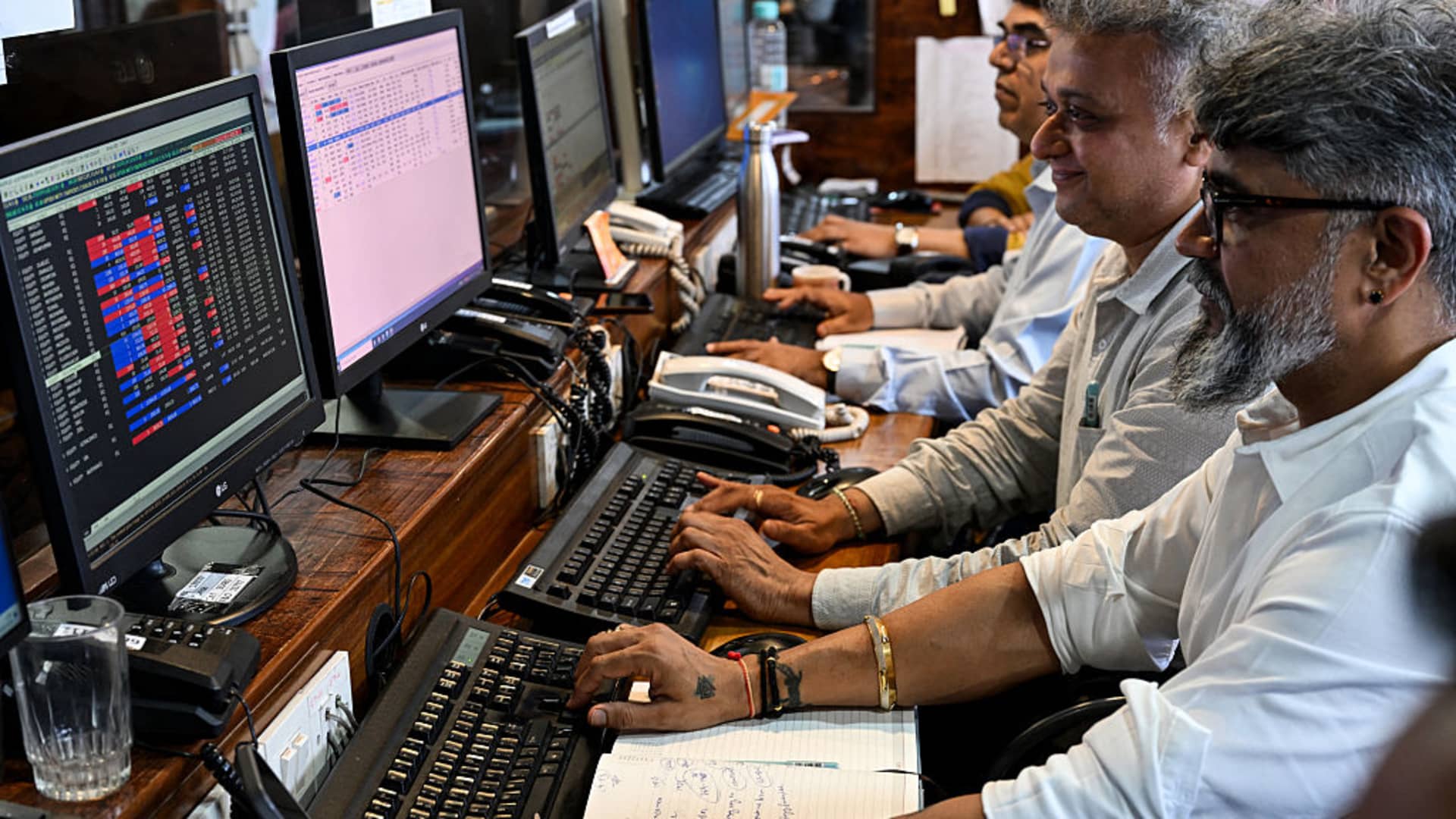Stock traders monitor share prices during an intra-day trading session at a brokerage house in Mumbai on April 8, 2025. Asian and European markets battled on April 8 to recover from the previous day’s tariff-fuelled collapse. US President Donald Trump slapped a flat 26 percent tariff on imports from India last week, with New Delhi saying it was examining both “implications” and “opportunities” from the duty hikes. (Photo by Indranil MUKHERJEE / AFP) (Photo by INDRANIL MUKHERJEE/AFP via Getty Images)
Indranil Mukherjee | Afp | Getty Images
This report is from this week’s CNBC’s “Inside India” newsletter which brings you timely, insightful news and market commentary on the emerging powerhouse and the big businesses behind its meteoric rise. Like what you see? You can subscribe here.
Each weekday, CNBC’s “Inside India” news show gives you news and market commentary on the emerging powerhouse businesses, and the people behind its rise. Livestream the show on YouTube and catch highlights here.
SHOWTIMES:
U.S.: Sunday-Thursday, 23:00-0000 ET
Asia: Monday-Friday, 11:00-12:00 SIN/HK, 08:30-09:30 India
Europe: Monday-Friday, 0500-06:00 CET
The big story
Having overcome fears of the India-Pakistan conflict, Indian markets might lose its temporary status as a “safe haven” market if the U.S. and China come to a deal.
Those worries and a concoction of other factors — inflation, earnings disappointments — have led to lackluster performance for equities so far this year. The Nifty 50 is up 4.7% so far this year, and investors are likely to have welcomed the sideways move by the benchmark in May with a sigh of relief, in fact.
But the tide may be about to turn as Wall Street analysts and investors turn bullish.

The Indian market is currently one of the most expensive globally, trading at over 20% premiums to its 20-year average price-to-earnings (P/E) ratio, which limits the potential for significant Nifty benchmark upside, according to analysts at CLSA.
“After the recent rally, the Indian market has again inched up to become nearly the most expensive market in the world,” said CLSA’s Vikash Kumar Jain in a note to clients.
Goldman Sachs strategists echoed that point, saying the MSCI India index “does not look favourable” even when adjusting for a stronger growth potential.
Wonks over at Morgan Stanley took a similar view of the stock market’s recent performance.
“Since September 2024, the market has digested an unprecedented amount of bad news – excessive valuations in [small and mid-cap] and a sharp correction in the broad market pointing to a slowdown in macro growth and earnings, US tariff-related volatility and a major terrorist attack along with India’s response with the large-cap indexes about 5% from all-time highs and almost negligible changes in implied volumes,” said the Wall Street bank’s Ridham Desai.
Norma analyst Saion Mukherjee also noted that most companies beat expectations for the latest quarter, but only because the expectations had been lowered significantly.
Yet, every single one of those market participants has turned bullish over the past couple of weeks.
Goldman Sachs raised its price target for the Nifty 50 to 26,200. Nomura similarly sees the index at 26,140.
Even long-time cautious bears such as Bernstein’s Venugopal Garre, who has been right in cautioning investors over rich valuations in the small and mid-cap sectors (SMID), are now rethinking their outlook.
“They’ve been in a bubble zone for a while — a point we’ve never hesitated stating,” said Garre. “The reality is this: the SMID bubbles have let go of a lot of froth and are broadly valued in line with recent history. Not cheap, and not exorbitant.”
And it’s not just strategists, analysts and advisors turning around. Money managers are also echoing the same sentiment.
“A lot of people look at India and have said, ‘Gosh, the valuations are enormous,'” said Andrew Dalrymple, chief investment officer at Aubrey Capital Management. “If you took that view, you’d never buy an Indian equity. You would have missed an enormous opportunity in the last five years.”
Aubrey Global Emerging Markets Strategy, which manages more than $500 million in assets, has 35% of its fund allocated to India, its largest allocation.
“We try to reconcile valuation of the price earnings-to-growth ratio, and say when we look at an Indian company, it might nominally have that high P/E but we then say this is justified by price-to-growth ratio, which we try to keep at less than 1.5 times,” Dalrymple added. “And that way, we find we have been able to exploit some extremely successful, very, very profitable investment opportunities over the years.”
Dalrymple’s sentiment is also reflected in the data. Foreign institutional investors have been net buyers of Indian equities over the past two months. Yet, it’s off a low base, suggesting a significant upside in an ideal scenario.
Morgan Stanley’s Desai noted that “foreign portfolios positioning is the weakest since we have had the data in 2000, and there are early signs that their view on India is shifting.”
Amid all the sudden bullishness, however, many investors have learned a thing or two over the past year and are approaching with caution.
“This is likely to be a stock pickers’ market, in contrast to one driven by top-down or macro factors since the Covid pandemic,” Desai said in a note to clients on June 2.
Financials, often viewed as a leveraged bet on the future of a nation, appear to be a favorite among many.
In the large-cap space, Axis Bank was a top pick for Nomura and Goldman Sachs, with ICICI Bank seen favorably by Morgan Stanley, CLSA and JP Morgan.
Need to know
India’s economy expands more than expected. Gross domestic product in the quarter ended March grew 7.4%. That figure’s much higher than the 6.7% expected by a Reuters poll of economists and the fastest rate of quarterly expansion for fiscal year 2025, according to government data released Friday. For the full fiscal year, India’s economy expanded by 6.5%, in line with the government’s February estimate.
U.S. authorities are reportedly investigating Adani’s companies. Prosecutors from the U.S. Attorney’s Office in Brooklyn are looking into whether Gautam Adani’s companies have been importing liquefied petroleum gas from Iran into India, according to the Wall Street Journal. A spokesperson for the Adani group “categorially denies” the allegations.
Reserve Bank of India expected to cut rates two more times. That’s according to Chetan Ahya, chief Asia economist at Morgan Stanley, who said that the RBI should be comfortable with two more rate cuts in the current economic climate because India’s “growth conditions will still be reasonable” and inflation is likely to remain below 4%.
Air travel by Indian nationals could cause the aviation industry to skyrocket. India is the third-largest air travel market in the world, Air India CEO Campbell Wilson told CNBC’s Monica Pitrelli at the World Air Transport Summit over the weekend. “So if Indians start traveling… at the intensity of China, it’s going to absolutely explode in volume internationally,” Wilson said.
— Yeo Boon Ping
What happened in the markets?
The Nifty 50 has stayed absolutely flat, so far this week. The index has risen 4.7% this year.
The benchmark 10-year Indian government bond yield moved lower by 3 basis points compared to last week.

On CNBC TV this week, Anubhuti Sahay, head of India economics research at Standard Chartered Bank, said that India’s fiscal fourth-quarter economic expansion was “much higher than anyone of us expected” because of growth in net indirect taxes. However, that number can “keep on fluctuating” and eventually fade, so India’s gross domestic product will likely return to the trend of 6.5%. The bank’s full-year forecast for India’s financial year 2026 is 6.6%.
Meanwhile, APEC President of Marriott International Rajeev Menon said that India is “one of the most strategic markets in the world” for the hotel chain. Menon pointed out that occupancy growth is driven by secondary and tertiary cities as much as demand from bigger cities like New Delhi and Bangalore, which suggests that the India’s rising middle class is a revenue opportunity for businesses.
— Yeo Boon Ping
What’s happening next week?
India’s central bank will announce its interest rate decision Friday, when it is expected to lower rates by 25 basis points to 5.75%, according to LSEG data. The country will also be releasing data on its consumer inflation rate for May next Thursday.
Meanwhile, Ganga Bath Fittings, a manufacturer of bathroom accessories, lists Wednesday.
June 6: Reserve Bank of India interest rate decision
June 11: Ganga Bath Fittings IPO
June 12: India consumer price index for May
— Yeo Boon Ping





